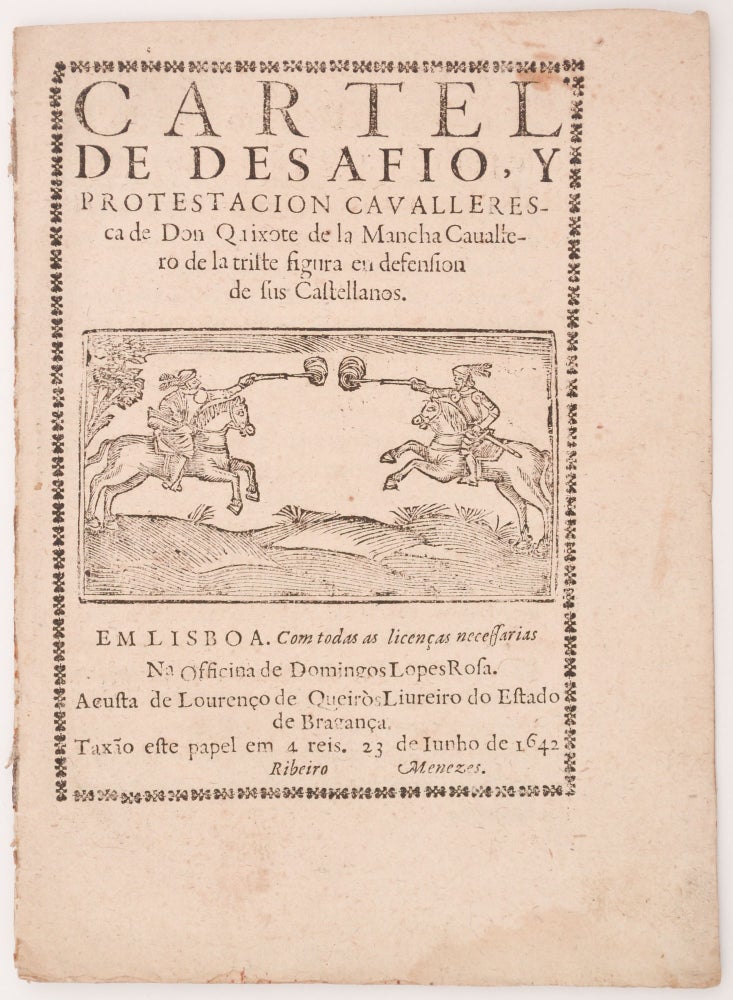Cartel de desafio, y protestacion cavalleresca de Don Quixote de la Mancha Cauvallero de la triste figura en defension de sus Castellanos.
Em Lisboa [Lisbon]: Na Officina de Domingos Lopes Rosa. Acusta de Lourenço Liureiro do Estado de Bragança. Taxão este papel em 4 reis., Riberiro Menezes [Domingos Lopes Rosa], 23 de Junho de 1642. First edition. Papered spine. Woodcut illustration of dueling horsemen on the title page. Title page in a typographical frame. A woodcut initial. [8] p. Occasional light stains throughout. Overall in fine condition.
“One of the first manifestations of the presence of Don Quixote in Lusitanian lands” (Vargas Díaz-Toledo, 2017). The first edition of this extremely scarce satirical political pamphlet concerning the Andalusian independentist conspiracy of 1641 and the Portuguese Restoration War.
Cartel de desafio fits into the rich tradition of Portuguese political, philosophical and literary texts speak for the independent and autonomous Portugal state appeared during the Philippine period, however this scarce pamphlet, a fine parody of a contemporary event, excels from the current of such writings, due its more more satirical, perhaps even anecdotal content (Dotras Bravo, Vargas Díaz-Toledo, 2011).
The author of this anonymously published booklet was certainly a competent reader of Quixote, who created an interesting intertextuality by transforming the characters from Cervantes into instruments of political struggle and turning Don Quixote to the adversary side, as a symbol and representation of the decline of Spain (Dotras Bravo, Vargas Díaz-Toledo, 2011). Although the language of the text is Spanish, Cartel de desafio is one of the earliest appearances of Don Quixote in Portugal literature (Vargas Díaz-Toledo, 2017).
The Andalusian independentist conspiracy was a failed attempt of Andalusia’s nobility to gain independence from Spain on the coat tail of the Portuguese Restoration War and the temporary success of the Catalan secessionist endeavor (Reapers' War). The conspiracy whose chief architects were Gaspar Alonso Pérez de Guzmán and Ninth Duke of Medina Sidonia (who are mentioned by name in the pamphlet), together with Francisco Manuel Silvestre de Guzmán, Sixth Marquis of Ayamonte, was discovered and brought to an end in the summer of 1641.
Extremely scarce. Outside of Portugal and Spain, we could trace only two copies in institutional holdings (Houghton Library, MA; Hispanic Society of America, NY).
Arouca C206; IB 24074; Palau 46419; Palau 46331
Literature: Dotras Bravo, A., Vargas Díaz-Toledo, A. (2011): Cartel de desafío, y protestación cavalleresca de Don Quixote de la Mancha Cavallero de la Triste Figura en defensión de sus castellanos. (Lisboa, Domingo Lopes, 1642). In: Coloquio-Letras. 178, pp. 77–86.; Vargas Díaz-Toledo, A. (2017): Cartel de desafío de don Gaspar Alonso Pérez de Guzmán el Bueno (1641): nuevos datos. In: Janus: estudios sobre el Siglo de Oro. No. 6 (2017). pp. 243–279.; Anastácio, Vanda: “Heróicas Virtudes e Escritos Que as Publiquem”. D. Quixote Nos Papéis Da Restauração. In: Iberoamericana Vol. 7, no. 28, 2007, pp. 117–136.
.
Price: €3,500.00


